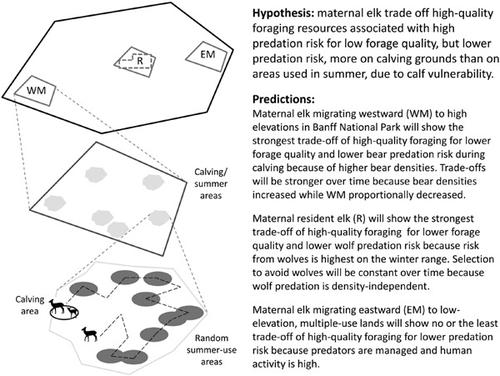当前位置:
X-MOL 学术
›
J. Wildl. Manage.
›
论文详情
Our official English website, www.x-mol.net, welcomes your
feedback! (Note: you will need to create a separate account there.)
Mothers' Movements: Shifts in Calving Area Selection by Partially Migratory Elk
Journal of Wildlife Management ( IF 1.9 ) Pub Date : 2021-07-20 , DOI: 10.1002/jwmg.22099 Jodi E. Berg 1 , Jody Reimer 1 , Peter Smolko 1 , Holger Bohm 1 , Mark Hebblewhite 2 , Evelyn H. Merrill 1
Journal of Wildlife Management ( IF 1.9 ) Pub Date : 2021-07-20 , DOI: 10.1002/jwmg.22099 Jodi E. Berg 1 , Jody Reimer 1 , Peter Smolko 1 , Holger Bohm 1 , Mark Hebblewhite 2 , Evelyn H. Merrill 1
Affiliation

|
Loss of migratory behavior or shifts in migratory ranges are growing concerns to wildlife managers. How ungulates prioritize safety from predators at the expense of high-quality foraging opportunities during calving may be key to understanding these shifts and long-term reproductive success. We compared trade-offs in selection for forage and predation risk by elk (Cervus canadensis) following 3 migratory tactics (western and eastern migration and resident) during 2 time periods in a declining (by almost 70% from 2002–2016), partially migratory elk population adjacent to Banff National Park in Alberta, Canada. We hypothesized that regardless of migratory tactic, maternal elk would show stronger trade-offs between high-quality foraging associated with higher predation risk and forage resources of lower-quality yet lower risk on calving ranges than on ranges used during summer because of vulnerability of their offspring. Additionally, we hypothesized these trade-offs would occur at high (2002–2006) and low (2013–2016) elk population sizes. We used a machine-learning algorithm to predict dates of parturition based on global positioning system (GPS) movements of elk equipped with vaginal implants (n = 60) and predictions were within 1.43 ± 0.85 (SE) days of the known date. We applied the model to an additional 58 GPS-collared elk without vaginal implants. Based on changes in localized movements, we defined calving areas as the 26 days post-parturition and compared habitat characteristics of calving areas to 10 similar-sized areas centered on random locations during summer for the same individual in a latent selection framework. Across the 2 time periods, parturition occurred from 8 May–11 July with median parturition dates differing among migratory tactics and residents shifting towards an earlier parturition date in the later period. All elk, regardless of migratory tactic and time period, selected calving areas with greater forage resources than were available on areas used during summer, with no evidence for greater selection of areas that reduced predation risk at the expense of higher-quality foraging. Calving season selection for areas with abundant forage exposed western migrants to high risk of bear (Ursus spp.) predation, residents to high risk of wolf (Canis lupus) predation, and eastern migrants to low risk of bear and wolf predation. Patterns in exposure to predation risk during calving between migratory tactics were consistent with the recent decline in western migrants and increase in eastern migrants, implying that conditions on calving areas contributed to observed changes in the number of elk following these tactics. © 2021 The Wildlife Society.
中文翻译:

母亲的运动:部分迁徙麋鹿在产犊区域选择方面的变化
野生动物管理者越来越担心迁徙行为的丧失或迁徙范围的变化。有蹄类动物如何以牺牲产犊期间的高质量觅食机会为代价,优先考虑来自捕食者的安全,这可能是理解这些变化和长期繁殖成功的关键。我们比较了麋鹿 ( Cervus canadensis)在选择饲料和捕食风险方面的权衡) 在两个时间段内采取 3 种迁徙策略(西部和东部迁徙和居民),在加拿大艾伯塔省班夫国家公园附近的部分迁徙麋鹿种群下降(从 2002 年到 2016 年减少了近 70%)。我们假设无论迁徙策略如何,母麋鹿都会在与较高捕食风险相关的高质量觅食和产犊范围内质量较低但风险较低的饲料资源之间表现出更强的权衡,因为它们的脆弱性在夏季使用的范围内后代。此外,我们假设这些权衡会发生在高 (2002-2006) 和低 (2013-2016) 麋鹿种群规模。我们使用机器学习算法根据装有阴道植入物的麋鹿的全球定位系统 (GPS) 运动来预测分娩日期 ( n = 60) 并且预测在已知日期的 1.43 ± 0.85 (SE) 天以内。我们将该模型应用于另外 58 只没有阴道植入物的带 GPS 项圈的麋鹿。根据局部运动的变化,我们将产犊区定义为分娩后 26 天,并将产犊区的栖息地特征与夏季期间以随机位置为中心的 10 个类似大小的区域在潜在选择框架中进行比较。在这两个时间段中,分娩发生在 5 月 8 日至 7 月 11 日,中间分娩日期因迁徙策略而异,并且居民在后期向较早的分娩日期转移。所有麋鹿,无论迁徙策略和时间段如何,都选择比夏季使用的地区拥有更多饲料资源的产犊地区,没有证据表明以牺牲更高质量的觅食为代价,可以选择更多的区域来降低捕食风险。牧草丰富地区的产犊季节选择使西部移民面临高熊风险(Ursus spp.) 捕食,居民对狼 ( Canis lupus ) 捕食的风险较高,而东部移民对熊和狼的捕食风险较低。在迁徙策略之间产犊期间暴露于捕食风险的模式与最近西部迁徙者的减少和东部迁徙者的增加是一致的,这意味着产犊区的条件有助于观察到遵循这些策略的麋鹿数量发生变化。© 2021 野生动物协会。
更新日期:2021-08-11
中文翻译:

母亲的运动:部分迁徙麋鹿在产犊区域选择方面的变化
野生动物管理者越来越担心迁徙行为的丧失或迁徙范围的变化。有蹄类动物如何以牺牲产犊期间的高质量觅食机会为代价,优先考虑来自捕食者的安全,这可能是理解这些变化和长期繁殖成功的关键。我们比较了麋鹿 ( Cervus canadensis)在选择饲料和捕食风险方面的权衡) 在两个时间段内采取 3 种迁徙策略(西部和东部迁徙和居民),在加拿大艾伯塔省班夫国家公园附近的部分迁徙麋鹿种群下降(从 2002 年到 2016 年减少了近 70%)。我们假设无论迁徙策略如何,母麋鹿都会在与较高捕食风险相关的高质量觅食和产犊范围内质量较低但风险较低的饲料资源之间表现出更强的权衡,因为它们的脆弱性在夏季使用的范围内后代。此外,我们假设这些权衡会发生在高 (2002-2006) 和低 (2013-2016) 麋鹿种群规模。我们使用机器学习算法根据装有阴道植入物的麋鹿的全球定位系统 (GPS) 运动来预测分娩日期 ( n = 60) 并且预测在已知日期的 1.43 ± 0.85 (SE) 天以内。我们将该模型应用于另外 58 只没有阴道植入物的带 GPS 项圈的麋鹿。根据局部运动的变化,我们将产犊区定义为分娩后 26 天,并将产犊区的栖息地特征与夏季期间以随机位置为中心的 10 个类似大小的区域在潜在选择框架中进行比较。在这两个时间段中,分娩发生在 5 月 8 日至 7 月 11 日,中间分娩日期因迁徙策略而异,并且居民在后期向较早的分娩日期转移。所有麋鹿,无论迁徙策略和时间段如何,都选择比夏季使用的地区拥有更多饲料资源的产犊地区,没有证据表明以牺牲更高质量的觅食为代价,可以选择更多的区域来降低捕食风险。牧草丰富地区的产犊季节选择使西部移民面临高熊风险(Ursus spp.) 捕食,居民对狼 ( Canis lupus ) 捕食的风险较高,而东部移民对熊和狼的捕食风险较低。在迁徙策略之间产犊期间暴露于捕食风险的模式与最近西部迁徙者的减少和东部迁徙者的增加是一致的,这意味着产犊区的条件有助于观察到遵循这些策略的麋鹿数量发生变化。© 2021 野生动物协会。











































 京公网安备 11010802027423号
京公网安备 11010802027423号